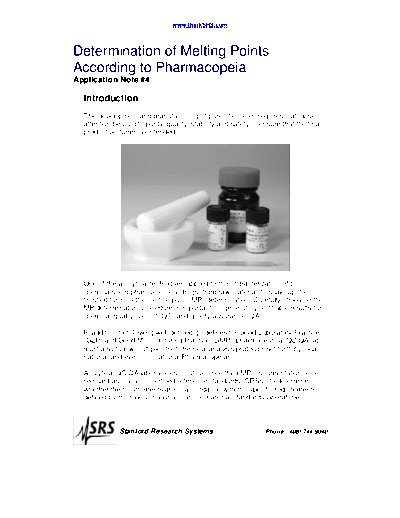Service Manuals, User Guides, Schematic Diagrams or docs for : Stanford Research Systems www.thinksrs.com-MP_Protocols
<< Back | HomeMost service manuals and schematics are PDF files, so You will need Adobre Acrobat Reader to view : Acrobat Download Some of the files are DjVu format. Readers and resources available here : DjVu Resources
For the compressed files, most common are zip and rar. Please, extract files with Your favorite compression software ( WinZip, WinRAR ... ) before viewing. If a document has multiple parts, You should download all, before extracting.
Good luck. Repair on Your own risk. Make sure You know what You are doing.
Image preview - the first page of the document

>> Download www.thinksrs.com-MP_Protocols documenatation <<
Text preview - extract from the document
www.thinkSRS.com
Determination of Melting Points
According to Pharmacopeia
Application Note #4
Introduction
The development and manufacturing of pure chemicals requires that close
attention be paid to purity, quality, stability and safety to ensure that the final
product performs as intended.
One of the analytical techniques applied to the characterization of pure
chemicals and pharmaceutical drugs (from raw material, to scale-up, to
finished form) is the melting point (MP) determination. Carefully choosing the
MP determination procedure is important for generating certifiable results for
chemical quality control (QC) and quality assurance (QA).
In addition to following well-defined guidelines for Good Laboratory Practice
(GLP) and Good Manufacturing Practice (GMP), pharmaceutical QC/QA labs
must also follow multiple strict chemical analysis protocols set forth by local,
national and even international Pharmacopeias.
Analytical QC/QA laboratories must calibrate their MP instrumentation on a
regular basis against certified reference standards (CRSs), to determine
whether their instruments are in accordance with the specific requirements
defined by their local, national and international standards laboratories.
Stanford Research Systems Phone: (408) 744-9040
www.thinkSRS.com
Determination of Melting Points According to Pharmacopeia
This application note describes some of the most widely accepted
Pharmacopeia protocols for MP determinations, and also includes a
comprehensive listing of CRSs commonly used for the calibration/validation of
MP instrumentation.
Important! Pharmacopeia procedures and CRSs are routinely updated,
supplemented, reformulated and revised. Use the information in this
application note for reference only, and always consult the latest
Pharmacopeia publications and supplements for up-to-date information on
MP determination protocols and certification procedures.
Stanford Research Systems Phone: (408) 744-9040
www.thinkSRS.com
Determination of Melting Points According to Pharmacopeia
U.S. Pharmacopeia
The United States Pharmacopeia (USP, http://www.usp.org/) is a non-
governmental, non-profit organization comprising of volunteer scientists. It
publishes the U.S. Pharmacopeia and National Formulary (USP-NF) which
contains the official, legally recognized standards for pharmaceutical
manufacturing.
MP Protocol
The MP Determination procedure is described in section <741>, p. 2033-2034
of the USP25-NF20 US Pharmacopeia. Five procedures for the determination
of melting range or temperature are provided, varying in accordance with the
nature of the substance.
USP-compatible capillaries are specified for MP determinations: 10 cm
length, 0.8 - 1.2 mm internal diameter and 0.2 - 0.3 mm wall thickness.
Capillary tubes must be charged with sufficient amount of the dry powder to
form a column in the bottom of the tube 2.5 - 3.5 mm high when packed down
as tightly as possible by tapping on a solid surface. The most common MP
procedure (Class Ia, Apparatus I) requires inserting the capillary with the
sample into the heating block 5◦ Jabse Service Manual Search 2024 ◦ Jabse Pravopis ◦ onTap.bg ◦ Other service manual resources online : Fixya ◦ eServiceinfo